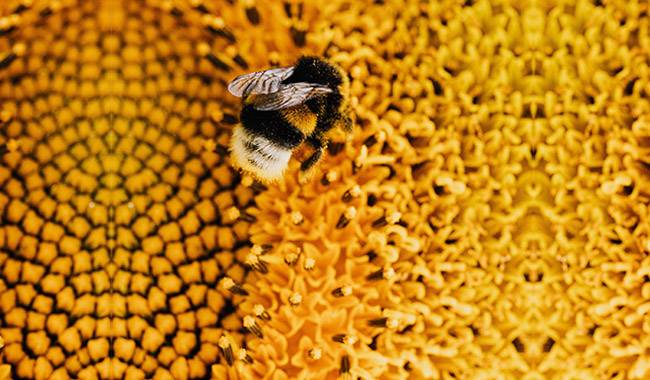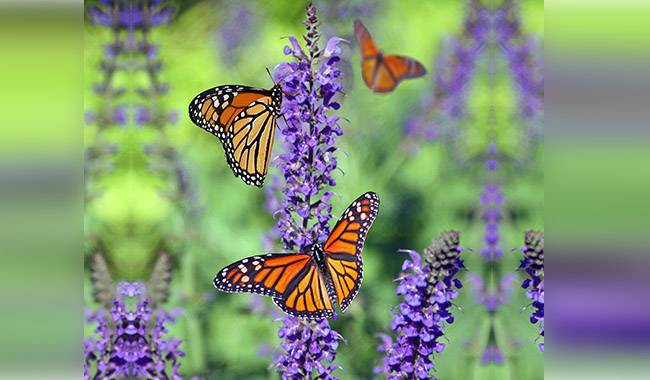
Cherry blossoms are in bloom, but there are not many fruits. Many people are familiar with this situation. It happens from time to time not only with cherries but also with many fruit trees. Or take zucchini as an example: after flowering, the uterus begins to rot. It seems – where is the cherry, where is the zucchini?
It turns out that the common cause – insufficient pollination. Although for millions of years plants this problem has “solved” itself, there are still failures. Here is an article about this important process, the participants, and how to help the “pollinators”.
HOW DOES POLLINATION WORK?
In the beginning, plants do not rely on anyone for the important process of fertilization. One only has to look at ferns, which are conservative in this matter, to get a sense of the complexity of the procedure. Hymenoptera, although a bit more advanced, also takes quite a long time.
Angiosperms decided to lead a new life and evolved stamens pistils. The process becomes even more interesting. At first, chaos as usual, then it became more and more specialized.
The pollination of blast wasps within figs is an extreme example. Figs can no longer reproduce without wasps, and wasps can no longer reproduce without figs.
There are two types of pollination: one is self-pollination, which relies only on itself, and the other is cross-pollination, which requires an intermediary. Self-pollination is more reliable, while cross-pollination is more progressive due to the expansion of genetic material, which has enormous advantages.
Gardeners know that the first generation (F1) hybrids obtained by cross-pollination of different species are superior to the “pure” ones in many ways.
Plants with egg flowers can self-pollinate, as in 75% of the natural world. Examples are tomatoes, peanuts, and peas. But this is not the best option.
Plants have a hard time self-pollinating. They also want to progress. Some by wrong maturation of stamens and pistils (apple trees, pear trees), some by different heights of stamens and pistils (maidenhair, buckwheat), others by self-pollination (cherry trees, red clover), and some by different sexes (buckthorn, forsythia).
Self-pollination, although advanced, is tied to intermediaries. This could be the wind (cereals, conifers, birch, hazel, alder), or insects, birds, or even bats. Insect pollinators are predominant.
To ensure that mature pollen is not wasted, flowering plants have “developed” many ways to attract insects and provide pollination. The flowers are brightly colored, the pollen is sticky, the fragrance is attractive, the nectar is sweet, and the planting site is convenient. More often than not, these methods are effective.
Some plants have gone the way of working with specific insects.
For example, clover – which can only be pollinated by long-necked insects: bumblebees and some species of honeybees. The massive die-off of bees in recent years and the decline in bumblebee populations suggest that this is not a good idea.
WHO HELPS PLANTS?
Without insect pollination, the existence of the vast majority of flowering plants (almost 90% of species) would no longer be possible. At the same time, a considerable part of the intermediary work is done by bees.
It turns out that honey and bee products on a global scale are by-products of the activity of bees. The most important job of hummingbirds is pollination, ensuring the growth of crops.
Bee pollination, by the way, is the cheapest method of increasing yields with an efficiency that is unmatched by any agricultural technology. In addition, bees contribute to crop yields not only by getting the products people need but most importantly by providing biodiversity.
We are talking about those bees in apiaries, but also about a large number of wild species, both solitary and communal. In general, there are about 21,000 species and 520 genera, distributed on all continents except Antarctica.
The bumblebee is a member of the true honeybee family. Wasps are not among them, but they are also good pollinators.
Many plants are pollinated by butterflies, usually those with nectaries at the base of the long, narrow corolla or stinging tube (honeysuckle, daffodils).
Daytime butterflies prefer bright colors – red, orange, purple. Nocturnal butterflies pollinate sweet-smelling pale flowers late at night and at night (e.g. cigarettes).
Here, the late-night blooming Japanese honeysuckle “Halliana”, smelling of Avon “Today” perfume, is attacked by revelers. They hover over the flowers. At dusk, it is accompanied by a dizzying fragrance that is breathtaking.
Pest butterflies make up only 2% of the population; the rest (or their offspring) eat nothing of significance.
Beetles specialize in pollinating large flowers, such as roses and lilies, or small inflorescences, such as dogwoods, elderberries, and umbrellas. The beetles’ sense of smell is more developed than their sense of sight, so they are attracted to sweet smells, such as fruity, spicy, or fermented flavors. However, plants pollinated by beetles are not brightly colored.
Incidentally, bees see things very differently than we do. They don’t think of red as a red color, and they do a good job of distinguishing between white, yellow, and blue.
These are the colors that are most likely to be found in bees. I have a bright yellow dress for work, and I often have bees fly by in the neighborhood to see: what can I get for such a big yellow dress?
Ants also have a number of pollinating umbrellas that they are happy to climb on to feed on the sweet nectar. They are also good at pollinating pumpkins, whose nectar is also sweet, and one does not have to climb too high.
European flies, cicadas, and many other small animals are also involved in pollination, but we tend to ignore them. But bees are ahead of the game.

BOUNDARY CONDITIONS AND FORCE MAJEURE
If the flowers bloom, it does not mean that there will be a harvest. The most important factor is the weather at the time of flowering. For example, in California hazelnut flowers very early: at the end of January or the beginning of February. Its northern sister, hazelwood plum, blooms in April.
The principle is the same, both provided by nature. In dry weather with daytime temperatures above 53°F (12°C), the male sepals grow at an incredible rate, the anthers split open from the dry air and throw up to 4 million pollen grains into the wind, per sepal!
“Pollination” lasts 1-2 weeks, and female flowers open for more than two weeks and seem certain to pollinate. But the weather is tricky and treacherous, and even meteorologists can only guarantee relative accuracy for five days.
It may rain for a very long time. Or snow, for example. That’s what we have this year. Two weeks of wet weather will undo all the efforts of the nuts and bolts aimed at population records.
This year’s spring has generally shown exquisite craftsmanship: temperatures of 71°F (22°C) have been in the shade for more than a week since the beginning of March. The apricots began to flow with sap on the trees, urgently snatching up the flowers.
As soon as the flowers opened, the nighttime temperature dropped to 19°F (-7°C). No longer waiting, the open apricot blossoms can only withstand temperatures of 29°F (-1.5°C).
For most flowering fruit, the critical temperature is 28°F (-2°C), in bud 26°F (-3°C), and the ovary will withstand 30°F (-1°C).
And that’s not all the possible trouble. In wet and cold weather during flowering – below 53°F (12°C) – the bees will not fly: the energy cost of flying and collecting nectar or pollen is not justified.
Accordingly, there will be few pollinated flowers. But they will, because flies, thrips, and white-eyes are still roaming the flowers at this time, although not as effective as bees.
The sunshine during flowering and the sudden spring heat add insult to injury: high temperatures, high winds, and dry air dry out the pistil stigma of the flower, pollen grains germinate poorly and the ovary forms defectively or not at all.
The plants, of course, over the preservation of about 1-2-3 days of weather trouble: seed plants are easily fertilized for 9-10 days, stone plants for 5-6 days, berries for 6-7 days. So there is a chance.
It goes without saying that a cross-pollinated garden should have at least 2-3 plants of each variety that bloom at the same time. If not, you need to graft other varieties to the canopy, plant pollinating plants, or encourage your neighbors to plant gardens.
POLLINATION OF VEGETABLES
Pollination of vegetables is even more interesting: during the flowering of nightshade plants, nighttime temperatures below 53°F (12°C), which we favor, greatly reduce pollen viability.
High temperatures-above 104°F (40°C), not uncommon in greenhouses)-lead to a complete loss of pollen viability. Poor air circulation also reduces pollination in nightshade. Even though nightshade is self-pollinating!
The situation is even worse with monoecious cucurbits: the pollen from the male flowers needs to be transferred to the female flowers and here it cannot be without insects. Cucumbers have parthenogenic cucumbers, but what about zucchini and squash?
In cool, humid weather, it is common to see the small subvarieties of squash or zucchini rotting. This is a sign of insufficient pollination. Bees and bumblebees don’t fly in this weather, and ants pollinate pumpkin plants by bringing in immature pollen.
HOW CAN WE HELP POLLINATE THE PLANTS?
The most important thing is to attract bees and bumblebees to the plot. It is best to find your own bees, but if conditions do not allow it, you can use other bees and wild bees. Most of all, they should be used to fly to the plot.
Most spring plants that bloom beautifully and are pleasing to the eye are not of interest to bees as gardeners. But there was a buzzing sound over the overgrown clover, with bees and bumblebees sitting on almost every flower.
Dandelions, again, are good bait. Also white clover. Not all bees have enough probe length for red clover. But bumblebees are good at it.
By the way, when the white clover is in bloom, our bees even ignore the phalaropes. Umbrellas are attractive to all insects. Let carrots, parsnips, cilantro, celery, parsley, and lovage bear fruit – you can also collect seeds.
Angelica can be incorporated into flower beds. Perennial onions, both edible and ornamental, are exceptionally good at attracting pollinators.
Spraying with insecticides during bloom and flowering is totally unacceptable!
If there are no herbaceous bees and the bees ignore the garden, you can spray the relevant preparations that attract them. And, since bees’ first reaction to color is color, you can put something round and bright yellow in the tree canopy or bushes. The bees will definitely look around if they do fly.
You can’t fight the weather, you can only reduce its negative effects to a certain extent. Smothering the garden during flowering raises the temperature a degree or two and preserves the reproductive organs of the plant. The same goes for sprinkling. You can spread a lot of soil under the trees late at night – the resulting mist will also improve the situation to some extent. If the plants are small, you can’t think of anything better than mulching material.
In a hot greenhouse, it is essential to arrange for ventilation, which is important for self-pollinating plants. Also, shake the stems of flowering tomatoes, peppers, and eggplants occasionally to encourage more aggressive pollination.
If setting up a pumpkin is depressing, “worker bees” can be used: pick a male flower and poke in a female flower. To be sure, it is best to pollinate two or three male flowers. The flower will choose a leader among all the pollen.
Dear reader, It is ideal when flowers are pollinated by insects that have long since cooperated and adapted to them. The little creatures that people keep troubling in one way or another do a great deal to keep the green flowering world alive. Take care of them!







